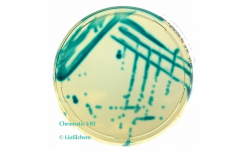Key Points
- Gram +ve, non-pathogenic, thermophilic and acidophilic spore forming bacteria
- Alicyclobacillus is a cause of microbial spoilage in fruit juices
- Aerobically grows over wide range of temperature and pH
- Can cause off flavours in beverages, spoilage may not be obvious as no gas is produced
- IFU Method for testing for Alicyclobacillus was revised in May 2019 (See Revised IFU Method)
- Alicyclobacillus spp. are also known as Thermophilic Acidophilic Bacteria (TAB)
Download the Ultrapure Type 1 Water Interview now ![]()
Introduction to Alicyclobacillus
Alicyclobacillus spp. are unusual and potentially important spoilage bacteria for the beverage industry. Until comparatively recently, only yeasts, moulds and a few lactic acid bacteria were considered capable of spoiling drinks based on, or containing fruit juices because of their low pH.
But in 1984, large-scale spoilage of ambient-stable aseptically packed apple juice by heat resistant bacteria was reported in Germany. This was the first recorded incident of fruit juice spoilage by bacteria now known as Alicyclobacillus. Since then, similar spoilage has been widely reported all over the world. These bacteria can be a serious problem because some strains are capable of producing a distinctive and powerful chemical taint in fruit-based drinks and they are difficult to control once present in the processing environment.
The availability of sensitive detection tests is therefore important for screening ingredients and finished products to ensure that they are free from Alicyclobacillus spp. A number of methods based on traditional and rapid technologies have been developed to meet this need.
History of AlicyclobacillusSpore-forming bacteria able to grow at high temperatures and low pH values were first isolated from thermal springs in Japan in 1967. These thermophilic acidophilic species were initially classified as Bacillus coagulans, but similar isolates from volcanic springs in the USA were classified as a new species and named Bacillus acidocaldarius.
A number of other species were later identified, including the isolate from the spoiled apple juice in Germany, subsequently named Bacillus acidoterrestris. But further genetic investigation revealed that these bacteria were in fact quite different from other Bacillus sp., and in 1992 the genus Alicyclobacillus was proposed as a suitable home for them. About 20 species of Alicylcobacillus have now been identified.
Alicyclobacillus' PhenotypeAlicyclobacillus spp., are Gram-positive, non-pathogenic, thermophilic and acidophilic spore-forming bacteria found in acid hot springs and in soil. They are aerobic and reported to grow over a very wide range of temperatures (4 - 70oC) and pH values (0.5 - 6.5), although isolates from spoiled fruit drinks do not usually grow at very low temperatures or under extreme acid conditions.
The spores are relatively heat-resistant and are capable of surviving the pasteurisation treatments typically applied to fruit juices and other shelf-stable beverages. It is thought that the 'heat shock' of pasteurisation may in fact promote spore germination. The ability of these bacteria to grow under the acid conditions in fruit juices means that they may multiply in the finished packaged product. Although Alicyclobacillus species seem to be quite common in fruit products, probably as a result of soil contamination, their presence does not always lead to spoilage. But where it does occur, it can be a serious and costly problem for drinks manufacturers.
Alicyclobacillus SpoilageSpoilage is not usually obvious because no gas is produced, and may go undetected until the product reaches the market and consumer complaints are received. Unfortunately, some isolates produce powerful tainting compounds as secondary metabolites, and these impart a characteristic taste and odour, often described as antiseptic, medicinal or phenolic. The most commonly detected tainting compound is guaiacol, but halophenols such as 2,6-dibromophenol have also been identified in spoiled drinks.
Large populations of Alicyclobacillus are not always necessary before detectable spoilage occurs. Numbers as low as 104 CFU/ml have been found in spoiled samples and growth can occur at ambient temperatures. The species most commonly associated with spoilage is A. acidoterrestris, but A. pomorum, A. acidocaldarius and A. acidiphilus can also produce tainting compounds and have been isolated from spoiled products occasionally. Spoilage has been reported in a range of beverage products, including various fruit juices and blended juice products, carbonated fruit drinks, iced tea and fruit flavoured water, as well as in canned tomatoes.
Culture-based methods in Alicyclobacillus testingThe inconspicuous nature of Alicyclobacillus growth in beverages can result in large-scale spoilage incidents with serious consequences for drinks manufacturers. This means that control of the organism in the manufacturing process is essential, but the heat resistance of the spores dictates that it is not easy to achieve. Screening of ingredients, especially fruit juices, for viable Alicyclobacillus spores has therefore become one of the key tools for preventing spoilage. Just as important from a quality assurance point of view is regular monitoring of finished products to ensure that controls are effective and to detect potential spoilage at an early stage. These requirements have driven the development of a range of methods, based on both traditional culture techniques and rapid technologies.
Alicyclobacillus DetectionAlicyclobacillus species do not grow well on the non-selective solid media typically used to determine total viable counts in food and beverages. As acidophiles, they require a reduced pH environment (pH ≤4.0). A number of different media have been adapted, or developed specifically to detect and/or enumerate Alicyclobacillus, including orange serum agar (OSA), acidified potato dextrose agar, K agar, YSG agar and Bacillus acidoterrestris medium (BAT). Various methods based on these have been developed, mainly by the beverage industry, for quality assurance purposes and suitable media are commercially available. Most of these are designed primarily to detect A. acidoterrestris. Attempts have also been made to develop standard method protocols, and although there is as yet no universally accepted method, the International Federation of Fruit Juice Producers (IFU) Method No. 12 is widely used. IFU method 12 includes procedures for the examination of raw materials, including process water, end products sampled immediately after processing and end products taken from the market to investigate possible spoilage. You can watch a short, 11 mins talk on the new IFU Method. 12:2019 by Dr. Andreas Bubert, Merck
Alicyclobacillus in Raw materialsSpores are of most concern in raw materials and the IFU method includes a heat shock treatment (typically equivalent to 80oC for 10 min) of the sample to promote spore germination. The sample can then be plated directly onto BAT agar or another suitable medium and incubated for 3-5 days at 45oC. Any visible colonies are presumptive Alicyclobacillus species. If low numbers of spores are a concern the sample can be enriched in BAT broth for 2-4 days at 45oC, or in the case of filterable samples, concentrated by membrane filtration before plating out.
Testing for Alicyclobacillus in Finished products after processingAgain the method is designed to detect spores, but a heat shock is not considered necessary immediately after pasteurisation. Since low numbers of spores are likely to be present, membrane filtration, pre-incubation of the finished product in its final packaging for seven days at 45oC, or enrichment in BAT broth is recommended before the samples are plated onto solid media.
Testing for Alicyclobacillus in Finished products from the distribution chainSamples can be pre-incubated for seven days at 45oC and optional heat shock treatment and enrichment procedures may also be applied. But where spoilage is suspected, viable Alicyclobacillus vegetative cells may be detectable by direct plating.
Confirmation and identification of AlicyclobacillusGrowth of selective media can be taken as a presumptive identification of Alicyclobacillus, but conventional confirmation testing can be unreliable. One commonly used approach is to test colonies for guaiacol production, since the compound is characteristic of tainting spoilage by A. terrestris. The method is based on the production of guaiacol from vanillin after incubation in a liquid medium and detection by the peroxidase enzyme colourimetric assay (PECA) test, which produces a brown coloured complex in the medium. A. acidoterrestris can be differentiated from A. acidocaldarius by incubating cultures at 30, 45 and 65oC. A. acidoterrestris does not grow at 65oC and A. acidocaldarius does not grow at 30oC
Rapid Methods in Testing for AlicyclobacillusConventional culture methods can take 10-12 days to detect the presence of Alicyclobacillus species in samples and a further 24 hours to confirm guaiacol production by isolates. Identification of isolates is likely to require even longer. It is not surprising therefore that research effort has been directed at reducing the time needed to achieve a result. A number of rapid technologies have been investigated and a few tests have been developed into commercial products for the beverage industry.
Detection of AlicyclobacillusFlow cytometry has been widely applied to beverages for determining total viable counts and the detection of yeasts, but its use for Alicyclobacillus detection has also been investigated. The technique depends on the fluorescent labelling of viable cells, which are then detected by a laser. Flow cytometry is not particularly sensitive and requires at least 103 cells per ml for detection to occur. This means that a time consuming pre-incubation or enrichment step will still be required, but the 3-5 days needed to culture the bacteria can be cut to about 10 hours. Molecular biology methods have been developed for rapid detection of Alicyclobacillus.
PCR-based detection methods have been widely investigated and several commercial test kits are available. BioTECON has developed the foodproof® Alicyclobacillus Detection Kit, which can be used with foodproof Sample Preparation Kits for real-time PCR detection of Alicyclobacillus species. The lower limit of detection is around 100 cells per ml, but the method is not able to detect spores, so that pre-incubation or enrichment is still needed to allow germination of spores and multiplication of vegetative cells, but only for 48 hours instead of 5-7 days. Detection then takes a matter of a few hours and the test kit is also able to identify A. acidoterrestris to species level.
Gene probe technology has also been employed to detect Alicyclobacillus and has been developed into a commercial product in the shape of the Sysmex VIT-Alicyclobacillus detection test. The test can be applied directly to enrichment cultures and to samples after a short (48 hours) pre-incubation, but without the need for DNA extraction. It uses fluorescent-labelled specific gene probes, which bind to rRNA within the bacterial cells during a short incubation period. Samples are then examined by fluorescence microscopy to detect and differentiate viable cells of Alicyclobacillus species and of A. acidoterrestris. The test produces results in three hours.
Identification of AlicyclobacillusThe difficulty of confirming presumptive Alicyclobacillus detection in samples and of identifying isolates by conventional techniques has lead to the investigation of alternative methods. Fourier transform infrared spectroscopy (FT-IR) has been used to analyse the components of the bacterial cell wall and membrane and has been shown to be capable of distinguishing between Alicyclobacillus species and other bacteria in cultures. FT-IR is also able to distinguish between different strains of A. acidoterrestris and to identify guaiacol-producing strains.
Molecular methods have shown promise in the identification of Alicyclobacillus species. For example, DNA ribotyping of the genes coding for 16S and 23S rRNA has been investigated and found to be capable of identifying many isolates. DNA sequencing has also been used successfully and the rapid advances in sequencing technology may soon make this a more practical and less expensive identification technique. Micro arrays designed to analyse the complete bacterial genome have been developed and are able not only to identify different species and strains, but also to identify markers for specific characteristics, such as guaiacol production.
Revised IFU Method 12:2019In May 2019, the revised method for simplified testing of Alicyclobacillus was published by the international fruit and vegetable Association IFU. The IFU method No. 12:2019 describes the detection and enumeration of spore-forming thermo-acidophilic spoilage bacteria, namely Alicyclobacillus. It is applicable for testing juice, juice related products and ingredients, environmental samples, for example, process water, and some non-juice beverages, for example, syrups. Watch explainer video here.
Get the latest updates in Rapid Microbiological Test Methods sent to your email? Subscribe to the free rapidmicrobiology eNewsletter























